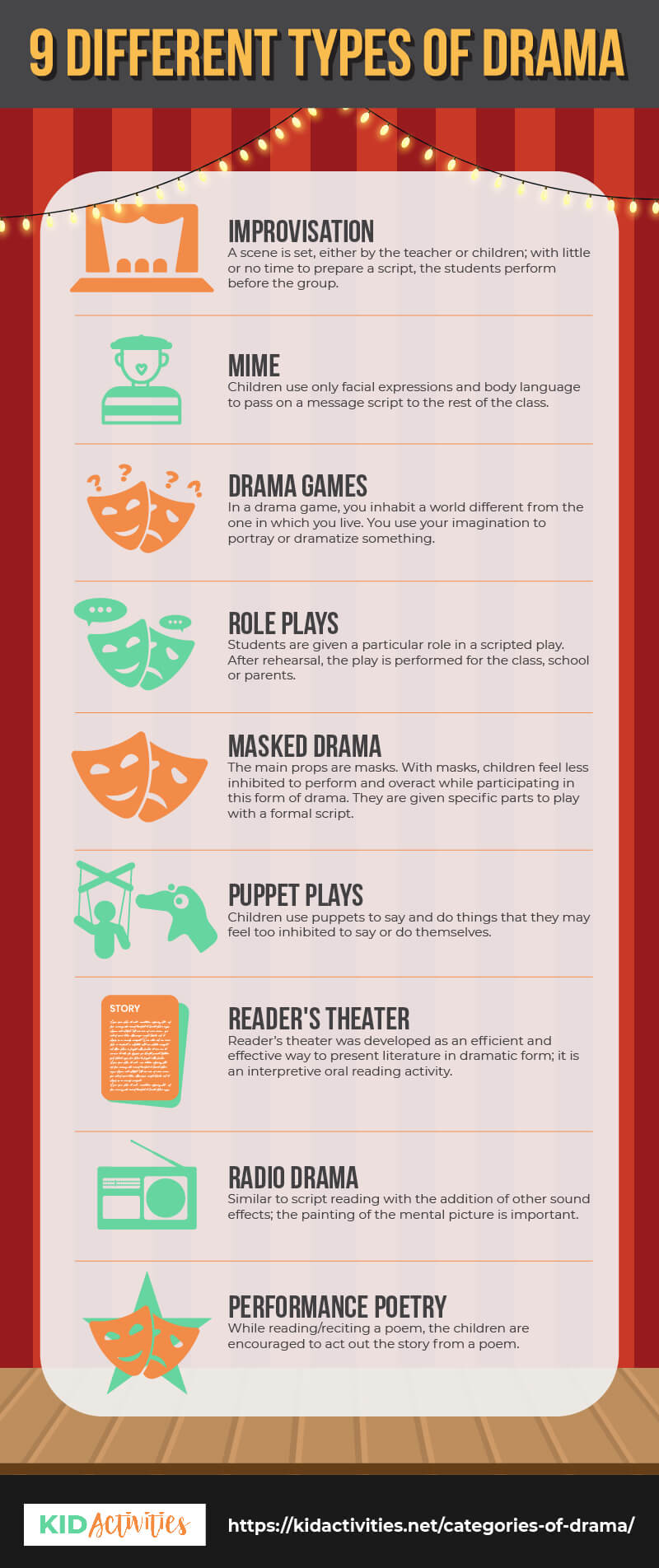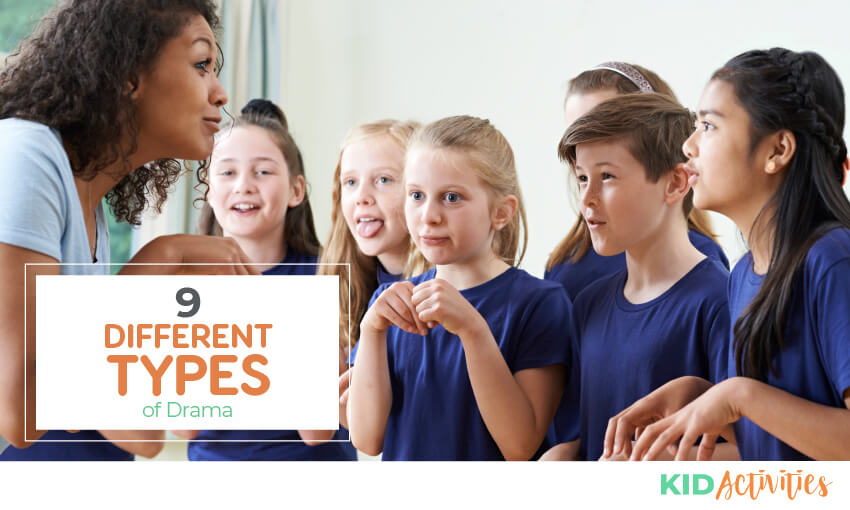There are many different types of drama. Here is a partial list with a simple explanation of each, including how it applies to literature.
Practicing the different types of drama can help students develop their skills. For example, practicing improvision could come in handy if they were to forget their lines in a role play.

Types of Drama in the classroom
1. Improvisation
A scene is set, either by the teacher or children, with little or no time to prepare a script, the students perform before the group.
2. Mime (Pantomime)
Children use only facial expressions and body language to pass on a message script to the rest of the class.
3. Drama Games
In a drama game, you inhabit a world different from the one in which you live. You use your imagination to portray or dramatize something. By your actions, you show others what you want to depict.
Acting out what you have prepared is an important part of “Drama Games”. Besides drama, you can build games by using dance, art, music, sports or any other type of activity. Improvising is a form of drama play.
4. Role Plays
Students are given a particular role in a scripted play. After rehearsal, the play is performed for the class, school or parents. Check out our line memorization tips.
5. Masked Drama
The main props are masks. With masks, children feel less inhibited to perform and overact while participating in this form of drama. They are given specific parts to play with a formal script.
The actors create the full picture for the rest of the group Interpreting content and expressing it using only the voice and body.
6. Puppet Plays
Children use puppets to say and do things that they may feel too inhibited to say or do themselves.
7. Reader’s Theater
Reader’s theater was developed as an efficient and effective way to present literature in dramatic form; it is an interpretive oral reading activity.
- Students use their voices, facial expressions, and hand gestures to interpret characters in scripts or stories.
- Teachers and students may adapt favorite stories for Readers’ Theater through scriptwriting activities. This is a wonderful activity for teachers and caregivers that are looking for ways to add fun, excitement, and meaning to oral reading activities.
- The very fact that the name contains the word “Readers”- indicates that it has a strong focus on the text. Text is the most important concept in Readers Theater.
8. Radio Drama
Similar to script reading with the addition of other sound effects, the painting of the mental picture is important.
9. Performance Poetry
While reading/reciting a poem, the children are encouraged to act out the story from a poem.
Different types of drama in literary
Drama in relation to literary is the act of performance of written words in books or poems and taking them to the stage. Actors get to act out a writer’s vision directly or have some sort of interpretation on it of their own.
But like a lot of things in life, there are several literary genres, and below we explain some of them with examples.
Opera
In Opera, the characters sing their lines instead of just speaking them. The whole idea is to create a musical event.
Farce
Farce is similar to comedy, it is less following a narrative of a story line and more on physical performance. silly jokes and gadgets.
Comedy
Here are the most common elements of humor:
- Clever jokes and phrases
- Usually have happy endings
- Silly characters
- Wordplay
Melodrama
Melodramas usually focus on a more serious story line and are not humorous in nature.
Tragedy
Usually have a sad or bad ending, opposite to comedy which usually ends in happy outcomes. Here are a few things to note when it comes to tragedy:
- Usually ends badly
- Events that usually get out of control ( not in a funny way )
More about the word drama
In Greek, the word Drama means action. It was Aristotle who started practicing drama in 335 B.C. This is the oldest ever recorded work of a dramatic theory. It than continued throughout Greek culture.
When the phenomenon known as Drama started spreading into Europe and France, the Roman Empire adapted it and simply called it theatre in France and England.
Conclusion
We hope you have enjoyed our list of 9 different types of drama. Remember, practicing in different areas will help round out the student’s skills.
Drama Menu Links
- The Different Types of Drama click here
- Pantomime, Tips and Games
- Improv Games and Exercises
- A Variety of Drama Games/Activities
- Costumes & makeup

